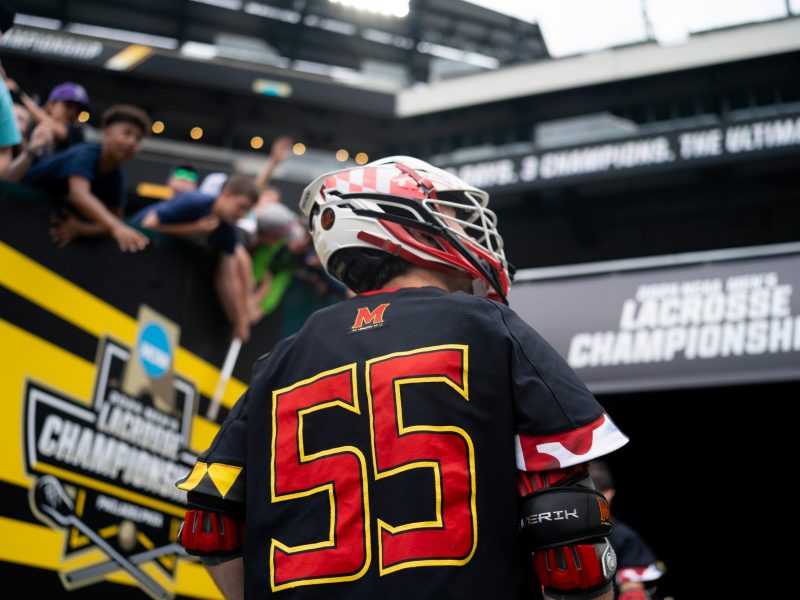Maryland men’s lacrosse suffered a blowout loss in the 2023 Big Ten tournament, its fifth defeat of the season. The Terps still hosted an automatic qualifier in the first round of the NCAA tournament.
Coach John Tillman’s squad is in a similar scenario one year later.
An inconsistent campaign resulted in five pre-NCAA tournament losses, the latest being the program’s largest defeat in 18 seasons. Maryland lost 19-9 to Penn State in the Big Ten semifinals. But the Division I Men’s Lacrosse Committee still awarded the Terps the No. 7 seed and the right to host an automatic qualifier in the first round on Saturday.
Maryland fell in the first round of the NCAA tournament last season. It’s hoping to avoid another early exit.
“We keep relaying it back to last year,” defender Ajax Zappitello said. “It’s something that sticks with everybody.”
The Terps have reiterated that it’s a new season since their dreadful loss to Penn State, a defeat that nearly left Maryland out of the NCAA tournament.
[Maryland men’s lacrosse earns No. 7 seed in NCAA tournament, lowest since 2019]
Of the 17 schools that made the tournament, nine received automatic bids via conference tournament titles, leaving only eight at-large spots. The Terps received the penultimate at-large bid, ahead of only the Nittany Lions.
“I think maybe being concerned that you might have lost the opportunity [to reach the NCAA tournament], maybe that’s a good thing for us,” Tillman said. “Realizing that you got a second chance.”
Maryland’s inconsistent campaign nearly snapped its run of 20 straight NCAA tournament appearances, the longest active streak in the nation. The inconsistencies have occurred throughout the season.
The Terps started 4-0 then lost three of four games. They both won and lost three contests by at least four goals.
Maryland’s lack of a star offensive player has led to a by-committee approach throughout their campaign. Seven different Terps have led the team in scoring in a game.
The offensive disparities have resulted in four sub-10 goal outings, ultimately leaving the Terps tied for the 50th-best scoring offense among all Division I schools. Their offense is the worst in the NCAA tournament.
Tillman has shuffled through three different starting lineups over Maryland’s past five games, partly due to an injury Daniel Maltz suffered late in the regular season. Tillman elected to use a new starting attack in the Big Ten tournament loss despite Maltz’s return.
Eric Malever, who started in each of the Terps’ first 12 games this season at attack, spent the contest in a new role on Maryland’s second midfield line. Tillman felt utilizing Malever out of the box would light a spark for the offense.
The result instead created another suboptimal offensive performance.
[Penn State demolishes Maryland men’s lacrosse in Big Ten semifinals, 19-9]
Braden Erksa, the Terps’ points leader, exited the game on a stretcher after receiving a heavy hit on a shot attempt in the second quarter. Tillman said Monday he needed to see how Erksa progressed through protocol for his status this weekend.
A potential Erksa absence would force another new starting attack.
Maryland’s defense, while more stable than the offense, is also looking to bounce back. The unit allowed seven goals or less in each of the final three regular season games but collapsed to surrender 19 goals to Penn State in the Big Ten tournament.
Zappitello, the Big Ten Defensive Player of the Year, struggled in his matchup against Offensive Player of the Year TJ Malone. The overall defense suffered as a result.
Malone’s first goal came as Zappitello failed to communicate with his unit on a pick, providing Malone with shooting space. Later in the game, Zappitello playing slightly off of Malone opened space to the left of the cage. The attacker found an angle and struck for his third goal of the contest.
Maryland’s inconsistencies have hampered its season thus far — the offense hasn’t found a reliable scorer and the defense has significantly worsened when Zappitello struggles. The Terps haven’t outscored their opponent in all four quarters of any contest.
In a win-or-go-home scenario, Maryland will need to play a consistent 60 minutes. It hasn’t achieved that yet.
“I don’t care the time of year, there’s always opportunities to get better,” Tillman said.



